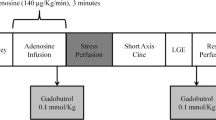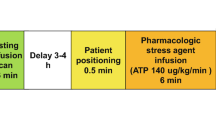Abstract
Background
The aim of this study was to assess the accuracy of stress 99m technetium tetrofosmin myocardial perfusion imaging for the diagnosis of in stent stenosis (ISS).
Methods
We studied 72 patients who underwent exercise or dobutamine stress 99m technetium tetrofosmin imaging, 0.9±0.5 years after percutaneous coronary interventions in which stents were deployed. Coronary angiography was performed within 3 months of the stress test. ISS was defined as ≥50% stenosis in a coronary segment with previous stenting. Significant coronary artery disease (CAD) was defined as ≥50% stenosis within or outside the stented coronary segment.
Results
The stent was deployed in 1 coronary artery in 52 patients, and in 2 coronary arteries in 20 patients (a total of 92 detected in 42 (58%) patients (51 stents). Reversible perfusion abnormalities were present in 34 of patients with ISS (sensitivity=81%, CI 70–94). Regional sensitivity for diagnosis of stenosis per stent was 76% (CI 65–88), specificity was 83% (CI 71–94) and accuracy was 79% (CI 69–85). Reversible perfusion abnormalities were detected in ≥2 vascular distributions in 15 of 22 patients with multi-vessel CAD and in 5 of 50 patients without (sensitivity for identifying multivessel CAD=68%, CI 50–89; specificity=90%, CI 82–98; and accuracy=83%, CI 75–90).
Conclusion
Stress 99m technetium tetrofosmin myocardial perfusion imaging is a useful non-invasive technique for the diagnosis of in stent stenosis and extent of CAD in patients with previous percutanenous coronary artery interventions.
Similar content being viewed by others
References
Anderson HV, Shaw RE, Brindis RG et al (2000) A contemporary overview of percutaneous coronary interventions: the American College of Cardiology-National Cardiovascular Data Registry (ACC-NCDR). J Am Coll Cardiol 39:1096–1103
Smith SC Jr, Dove JT, Jacobs AK et al (2001) ACC/AHA guidelines of percutaneous coronary interventions (revision of the 1993 PTCA guidelines)—executive summary. A report of the American College of Cardiology/American Heart Association Task Force on Practice Guidelines committee to revise the 1993 guidelines for percutaneous transluminal coronary angioplasty). J Am Coll Cardiol 37:2215–2239
Lowe HC, Oesterle SN, Khachigian LM (2002) Coronary in-stent restenosis: current status and future strategies. J␣Am Coll Cardiol 39:183–193
Giedd KN, Bergmann SR (2004) Myocardial perfusion imaging following percutaneous coronary intervention: the importance of restenosis, disease progression, and directed reintervention. J Am Coll Cardiol. 43:328–36 Review
Kósa I, Blasini R, Schneider-Eicke J et al (1998) Myocardial perfusion scintigraphy to evaluate patients after coronary stent implantation. J Nucl Med 39:1307–1311
Milavetz JJ, Miller JD, Hodge DO, Holmes DR, Gibbons RJ (1998) Accuracy of single-photon emission computed tomography myocardial perfusion imaging in patients with stents in native coronary arteries. Am J Cardiol 82:857–861
Beller GA, Zaret BL (2000) Contributions of nuclear cardiology to diagnosis and prognosis of patients with coronary artery disease. Circulation 101:1465–1478
Bachmann R, Sechtem U, Voth E, Schroder J, Hopp HW, Schicha H (1997) Dipyridamole scintigraphy and intravascular ultrasound after successful coronary intervention. J Nucl Med 38:553–558
Milan E, Zoccarato O, Terzi A et al (1996) Technetium-99m-sestamibi SPECT to detect restenosis after successful percutaneous coronary angioplasty. J Nucl Med 37:1300–1405
Beygui F, Le Feuvre C, Maunoury C et al (2000) Detection of coronary restenosis by exercise electrocardiography thallium-201 perfusion imaging and coronary angiography in asymptomatic patients after percutaneous transluminal coronary angioplasty. Am J Cardiol. 86:35–40
Galassi AR, Foti R, Azzarelli S et al (2000) Usefulness of exercise tomographic perfusion imaging for detection of restenosis after coronary stent implantation. Am J Cardiol 85:1362–1364
Elhendy A, Schinkel AF, van Domburg RT, Bax JJ, Valkema R, Poldermans D (2003) Risk stratification of patients after myocardial revascularization by stress Tc-99m tetrofosmin myocardial perfusion tomography. J Nucl Cardiol 10:615–22
Smith EJ, Hussain A, Manoharan M, Testa HJ, Curzen NP (2004) A reverse perfusion pattern during Technetium-99m stress myocardial perfusion imaging does not predict flow limiting coronary artery disease. Int J Cardiovasc Imaging 20:321–6
Zellweger MJ, Weinbacher M, Zutter AW, Jeger RV, Mueller-Brand J, Kaiser C, Buser PT, Pfisterer ME (2003) Long-term outcome of patients with silent versus symptomatic ischemia six months after percutaneous coronary intervention and stenting. J Am Coll Cardiol 42:33–40
Lee J, Chae SC, Lee K, Heo J, Iskandrian AS (1994) Biokinetics of thallium-201 in normal subjects: comparison between adenosine, dipyridamole, dobutamine and exercise. J Nucl Med 35:535–541
Tadamura E, Iida H, Matsumoto K et al (2001) Comparison of myocardial blood flow during dobutamine-atropine infusion with that after dipyridamole administration in normal men. J Am Coll Cardiol 37:130–136
Bin JP, Le DE, Jayaweera AR, Coggins MP, Wei K, Kaul S (2003) Direct effects of dobutamine on the coronary microcirculation: comparison with adenosine using myocardial contrast echocardiography. J Am Soc Echocardiogr 16:871–879
Elhendy A, Bax JJ, Poldermans D (2002) Dobutamine stress myocardial perfusion imaging in coronary artery disease. J Nucl Med 43:1634–1646
Acknowledgement
This study was supported in part by a publication grant from GE Health Care.
Author information
Authors and Affiliations
Corresponding author
Rights and permissions
About this article
Cite this article
Elhendy, A., Schinkel, A.F., van Domberg, R.T. et al. Non-invasive diagnosis of in stent stenosis by stress 99m technetium tetrofosmin myocardial perfusion imaging. Int J Cardiovasc Imaging 22, 657–662 (2006). https://doi.org/10.1007/s10554-006-9087-6
Received:
Accepted:
Published:
Issue Date:
DOI: https://doi.org/10.1007/s10554-006-9087-6




